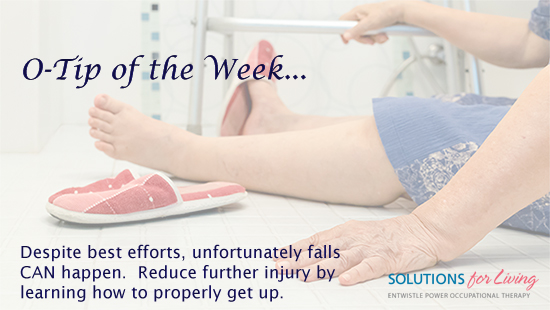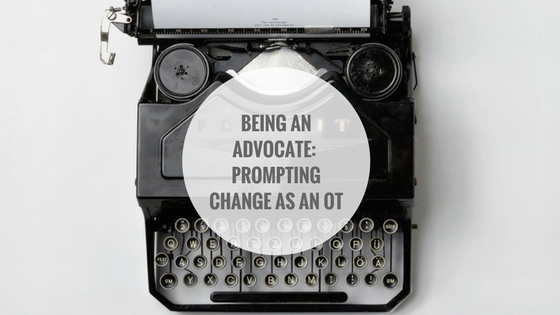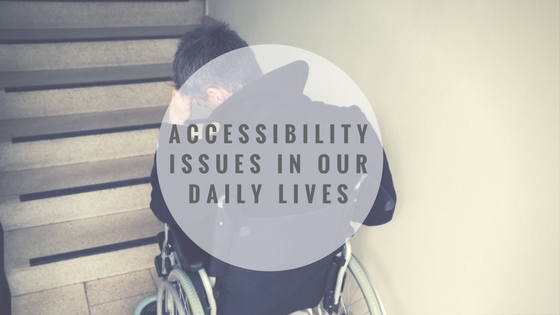On the second day of Inspiration my OT gave to me…
The story of a groom who, after taking his wedding vows, became a hero by jumping into a nearby river to save the life of a little boy.

On the second day of Inspiration my OT gave to me…
The story of a groom who, after taking his wedding vows, became a hero by jumping into a nearby river to save the life of a little boy.

Once again we are wrapping up the year with our 12 Days of Inspiration series, filled with wonderful stories of people across the world giving back in unique ways.
On the first day of Inspiration my OT gave to me…
The legacy of a Canadian Treasure who we lost this year, but who’s impact has left us a better country.
Macleans: How we will miss Gord Downie and the Tragically Hip

Our O-Tip of the week series we will be providing valuable “OT-Approved Life Hacks” to provide you with simple and helpful solutions for living.
For the month of November, Fall Prevention Month, our O-Tip series will concentrate on preventing falls at home and in the community.
Despite best efforts to reduce the risk of falling at home and in the community, falls DO still occur. It is important to be aware of the steps to take to get up from a fall to help prevent further injury.
The following from the 2017 Fall Prevention Month Toolkit provides step-by-step instructions to safely get up from a fall:
Find more helpful resources on Fall Prevention by visiting http://fallpreventionmonth.ca/.

Guest Blogger Lauren Heinken, Student Occupational Therapist
The Current Market
Over the last few years housing prices have been on the rise throughout most of Canada. The GTA in particular has seen soaring real estate prices, but this done little to deter buyers. Houses are selling quickly, and sellers often receive multiple offers that are well above asking price. This makes purchasing a home difficult, and those with accessibility needs may face additional challenges throughout this process. This, combined with an aging population of people trying to downsize or find more “suitable” homes, makes for a unique opportunity to enlist the expertise of an Occupational Therapist (OT) for buying consultation.
An Unlikely Partnership
It is not often that one would think of an OT partnering with a real estate agent or broker to provide homebuyer services. However, this synergy, as I will explain, could have beneficial outcomes for all involved.
OTs are all about helping people function, and our homes are at the core of where we spend most of our time. The home can be a support or a barrier to our physical, mental and emotional health. It can help us go about our daily activities easily, or can make managing a struggle. It can impact our mood – positively or negatively and either be a determinant of good health, or a cause of injury, sickness or death. Therefore, finding the right home is essential for reasons beyond just aesthetics, price tag and neighborhood. Yet, homes vary greatly, and the current real estate market moves quickly, so finding just the right fit, especially for those with a disability, can prove difficult.
An OT is well suited to assist in the home buying/modification process, and can bridge the knowledge gap that may exist in addressing the unique needs of the person with realtors who have their own knowledge of homes, the housing market, and the buying process. Realtors and OT’s joining forces has the potential to change the way people with unique accessibility needs shop for, and purchase, their next home.
The infographic below summarizes a potential service delivery model involving OT and real estate:
 Payment for Services and Benefits to the Real Estate Agent or Brokerage
Payment for Services and Benefits to the Real Estate Agent or Brokerage
Funding for this service could come from multiple sources, including the real estate agent or brokerage, the customer themselves, and there are also grants and charitable funding options that might be available. If the real estate brokerage is providing payment they will incur OT fees as part of their cost, so as to provide an accessible home buying experience for their clients. Having this service as an available option may help the agent or broker to attract a new segment of the home buyer population, thereby increasing their own marketability and profitability in this area. This would ideally produce positive economic gains for the brokerage that far exceed the costs they will be paying for OT consultation. Or, at the least, the OT should be a “vendor” on the list of other vendors the agent typically supplies to clients during the buy / sell phase (i.e. like movers, stagers, painters etc.). Then, the client can call the OT to discuss pricing as they would any other supplier.
As the OT profession grows over time, opportunities for partnership with other professionals outside of the usual allied health circle are going to become increasingly common. Thinking forward to opportunities that may exist creates the opportunity for OT’s and other professionals to work together for optimal service outcomes.

December is, legitimately, the most stressful month of the year. Shopping and presents, food preparation, cards, socializing, crowds, different schedules and routines, decorations, spending, pressure to buy the right thing for the right person – and not forgetting anyone.
I wanted to offer some practical suggestions to reduce stress and help you enjoy the holiday season this year. Here are Julie’s TOP 10 TIPS based on my own experiences as a busy mom, but also as an occupational therapist who often helps people to break down tasks into more manageable, and less stressful chunks:

Our O-Tip of the week series we will be providing valuable “OT-Approved Life Hacks” to provide you with simple and helpful solutions for living.
For the month of November, Fall Prevention Month, our O-Tip series will concentrate on preventing falls at home and in the community.
Falls are the leading cause of injury among older Canadians with 20-30% of seniors experiencing one or more falls each year (Statistics Canada). With seniors most falls often happen when someone is just trying to go about their day by having a shower, coming down the stairs, or taking a leisurely walk.
This week’s O-Tip of the Week returns to the bathroom, which can be the most dangerous room in the home, especially for seniors. Transitions into and out of the tub or shower are often the cause of falls in the bathroom. The installation of grab bars in the tub or shower can greatly reduce this risk. An Occupational Therapist can help by assessing the older adult’s functional status and reviewing the hazards in their environment that may put them at risk for falling.
Learn more helpful fall prevention tips for older adults from our infographic: An OT Knows How to Help Seniors Age in Place.

Julie Entwistle, MBA, BHSc (OT), BSc (Health / Gerontology)
As Occupational Therapists, we spend a significant amount of time with people in their homes and in the community. In this role, we witness daily injustices, challenges or problems that our clients unnecessarily or unfortunately experience due to vendors, landlords, or business owners / operators failing to understand, care, or address the needs of people with disabilities.
Recently, a student I was supervising on placement experienced an accessibility challenge with a client as they attended a local coffee shop. We blogged about this in our post, Accessibility Issues in Our Daily Lives. As her mentor, I discussed with her the need to advocate for change and to send the owner a letter about the problems that client experienced.
That situation made me reflect on my history of advocacy as a person and an OT. I remember as a teen writing a letter to a restaurant who would not book us a reservation on the “main floor” such that my two disabled grandparents could attend my birthday dinner. As a young adult, I wrote a letter to an Alaskan cruise line about the challenges my grandfather experienced using his scooter around the boat and on the gangways. Then I became an OT and the advocacy continued. I have written, and continue to write, letters to equipment vendors, drug and department stores, public and private places, major banks, landlords, the CCAC, and fast food restaurants. Sometimes my letters are specific and highlight an “incident”, while others speak more to general accessibility or service problems. My advocacy initiatives even resulted in me building a training program aimed at helping the “average Joe” best service people with disabilities. I personally feel that advocacy is how I will make my mark on the world, regardless of how small, with the hope of leaving this world in better shape than how I found it.
For this blog, I wanted to take the spirit of advocacy further, and to embrace our human responsibility to try and be catalysts of social, environmental and institutional change, by sharing a guide of sorts that could be used by other therapists, clients, caregivers or really anyone who wants or needs to bring an issue to someone’s attention. Give this a try and keep us posted on your outcomes:
DATE
Name of Person / Establishment
Address
Dear Representative/Manager/Person:
I am X. On DATE (I, my family member, client etc) experienced the following problems (when accessing your establishment, using your services, interacting with your staff, etc):
In bullet or paragraph format, list the problems you had. Be factual, truthful and professional. Avoid judgement, anger or threats as these will not result in change.
Provide some input on how you feel the problems you had might be impacting their service, business, etc. Try to hit home with how the issues you experienced will turn people away, or jeopardize their reputation.
Next, explain what you feel the solutions are or how it can be better for you next time. Help them to know what to do. You don’t have to be prescriptive or specific, but maybe they need to consider some building modifications, better trained staff, to understand disability codes or acts, an easier to navigate website, consultation with someone who can develop solutions with them etc. This is where you can really try to be helpful.
End the letter by thanking them for considering your feedback and provide your contact information. Be prepared to have a discussion with them about it. Some might ignore your letter, but I hope most will not. Either way, if your letter stays friendly and is perceived as helpful, they may want to thank you for your time or seek more input.
Of course, add a final sign off like “sincerely” and your name.
I hope this format / suggestion will be helpful as you venture forward and try to educate, share and advocate for the change you hope to see in the world.

Pain is real. It can prevent people from engaging in activities that are important to them, or at the least inhibit enjoyment and full participation in those things they want and need to do. It doesn’t matter if the cause of the pain is fully understood — the person’s experience of pain is what is important, and is what affects function. As the role of an occupational therapist is to enable clients to engage in activities that they want, need, or are expected to do, OT’s have the capability to help individuals with chronic pain to better manage their lives.
The following from article from Medical Xpress sheds light onto the benefits of OT for managing chronic pain and helping sufferers maintain a better quality of life.
Medical Xpress: Occupational therapy shown to improve lives of people in chronic pain
Learn more about how OT can assist with chronic pain in the following episdoe from our OT-V series, Managing Chronic Pain.

Our O-Tip of the week series we will be providing valuable “OT-Approved Life Hacks” to provide you with simple and helpful solutions for living.
For the month of November, Fall Prevention Month, our O-Tip series will concentrate on preventing falls at home and in the community.
This week’s O-Tip of the Week focuses on a simple, yet often forgotten aspect of the home that can prevent falls: proper lighting.
Seniors need to be attuned to the physical, balance and vision changes they are experiencing as they age, and need to consider the importance of proper lighting to help them navigate and reduce the risk of falls in their living spaces. Helpful and simple lighting suggestions may include:
– Night lights around the home
– A bed side lamp
– Illuminated light switches
– Storage of flashlights in the bedrooms, the kitchen and bathrooms
– Change of light fixtures to provide both ambient and task lighting based on needs
An Occupational Therapist can assist in assessing the living space to suggest lighting modifications and more. Learn more about how OT’s assist in fall reduction in our OT-V Episode, Fall Prevention.

Guest Blogger: Carolyn Rocca, Occupational Therapist
As I stroll into my favourite coffee shop to start my morning, I am reminded that this is a part of my day that I take for granted. Particularly, I am reminded of an observed experience that I encountered with a client who had a personal goal around using his walker to go into his favourite local coffee shop, something he had not been able to do since his brain injury.
After weeks of working up to this goal, it was finally time to assess his mobility in the community. As soon as we arrived at the coffee shop’s parking lot I could tell that this was going to be much more challenging than I had anticipated, as it quickly became apparent that there were several accessibility issues we would need to navigate.
Although the accessible parking spots provided us enough room to safely transfer out of the vehicle, and the ramp onto the side walk was graded appropriately, once up on the sidewalk, the client could sense a shallow slant in the pavement causing him to panic as he felt he was going to fall over. What became even more challenging was that there were no automatic doors at either entrance, and that the front entrance had a tightly-spaced vestibule with two sequential, single-passageway doors. On top of all of these challenges, there was about a 2-inch difference in the threshold of the door meaning the client had to lift his walker while already feeling nervous about the slanted pavement. Ultimately, the inaccessible nature of this establishment meant that it took over four people to safely get the client into the coffee shop, which not only increased his nervousness but also completely decreased his level of independence.
Although this experience was largely a success and the client was incredibly proud of what he had accomplished, it also brought to light some issues in our society. It was shocking that a well-established company (who shall remain nameless) had not yet invested in making all of their franchises accessible.
According to the updated accessibility requirements of the Ontario Building Code, buildings are required to have a barrier-free path of travel by having powered door operators at their entrances, meeting minimum requirements for doorway widths and ramp dimensions, and having adequate turning space (Ministry of Municipal Affairs, 2015). The unfortunate part is that these requirements do not affect existing buildings, and are only applied to newly constructed buildings or those undergoing extensive renovations.
What this means is that the current level of accessibility of this coffee shop will not be improved until this franchise decides to undergo major renovations. As a result, this franchise is not only impacting those who use gait aids or wheelchairs, it is also impacting individuals who have mobility challenges, low vision, and parents with strollers, to simply name a few. Additionally, according to the Royal Bank of Canada, people with disabilities have an estimated spending power of about $25 billion annually across Canada (Accessibility Ontario, 2017), meaning this franchise is also losing valuable business from a population who happens to love their coffee.
In being reminded of this experience, it also brings to light the impact that the profession of occupational therapy can have in terms of advocating for their clients needs and promoting equal access for all. Occupational Therapists (OTs) have a unique skill set in terms of assessing the needs of individuals, and identifying barriers in their environments that prevent their access or ability to engage in occupations that are important to them, such as grabbing a coffee. OTs teach people how to be proactive in their own lives, but bigger than this, also have the ability to communicate their clients’ / societies needs to others, and to offer solutions to barriers by involving appropriate stakeholders.
As such, I have written a letter to the coffee shop to bring awareness and attention to the challenges my client experienced while at their establishment. Moreover, in the future, I plan to examine buildings and public spaces beforehand to make sure I am helping my clients to be familiar with, and access, places that have the appropriate supports in place to maximize their level of safety and independence. In doing so, I will increase my clients’ future independence as they venture out without me, while also supporting businesses that have dedicated their time, effort, and resources to creating welcoming and barrier-free environments.
References
Accessibility Ontario (2017). About the Accessibility for Ontarians with Disabilities Act (AODA). Retrieved from https://accessontario.com/aoda/
Ministry of Municipal Affairs (2015). Overview of updated accessibility requirements. Retrieved from http://www.mah.gov.on.ca/Page10547.aspx